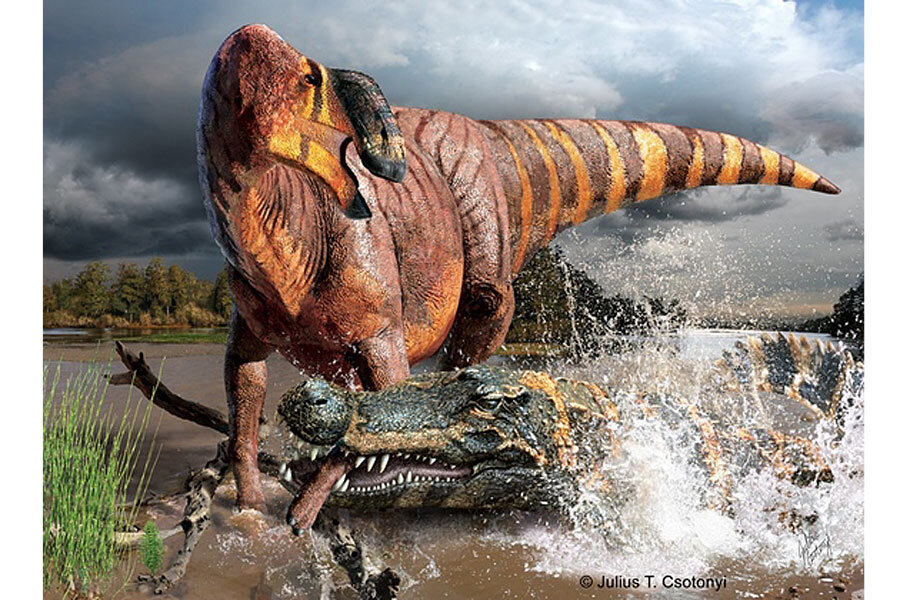Cretaceous-period dinosaur had a rather large nose, say scientists
Loading...
The remains of a big-nosed dinosaur that stalked the Earth some 75 million years ago, possibly luring mates with its beauty of a schnozzle, have been discovered in central Utah.
The beast's giant nose earned the dinosaur the name Rhinorex condrupus, with the Latin word Rhinorex meaning "king nose." And it surely sported a large sniffer, having the largest nasal opening, relative to its size, of any duck-billed dinosaur and among the largest of any dinosaur, according to Terry Gates, a joint postdoctoral researcher with NC State and the North Carolina Museum of Natural Sciences.
"The purpose of such a big nose is still a mystery," Gates said in a statement. "If this dinosaur is anything like its relatives then it likely did not have a super sense of smell; but maybe the nose was used as a means of attracting mates, recognizing members of its species, or even as a large attachment for a plant-smashing beak." [In Images: Discovering a Duck-Billed Dinosaur Baby]
The plant-eating beast was a type of hadrosaur, also called a duck-billed dinosaur. While hadrosaurs are known for their ornate head crests, which may have been used for communication, some members of the group, including the newbie, were crestless, the researchers noted.
Rather, this paleo-beast stood out for its nose and a few other distinctive features.
"Unlike other related duck-billed dinos, a small spur is present on the bottom of the nose bone that makes this region look like a fishing hook with a barb," Gates told Live Science in an email. "I don't know why it would be there." In addition, a projection that extends from its face bone flares in a different way than it does on other hadrosaurs, she added.
Gates and Rodney Sheetz from the Brigham Young Museum of Paleontology spotted the partial skeleton and skull in storage at BYU. The fossils were first uncovered in the 1990s from the Neslen formation in Utah's Book Cliffs, making it the only complete hadrosaur from this locale.
"We had almost the entire skull, which was wonderful, but the preparation was very difficult," Gates said in the statement. "It took two years to dig the fossil out of the sandstone it was embedded in — it was like digging a dinosaur skull out of a concrete driveway."
Once the researchers had pieced together the skull, they realized this was a new species.
R. condrupus was about 30 feet (9 meters) long and weighed more than 8,500 lbs. (3,900 kilograms) when alive and stomping around its swampy environment about 50 miles (80 kilometers) from the coast.
The researchers aren't sure exactly how the dinosaur died, though they have found some clues, including where the bones were found buried, suggesting it died in a river. "There are skin impressions preserved with the specimen meaning that it was buried relatively quickly after death, and most of the skeleton is still articulated, meaning that the bones never left their life position," Gates said in the email. "So whatever happened, happened fast to kill this Rhinorex."
Perhaps the beast was killed during a crocodile attack. "It seemed like a great possibility that such an attack could have caused the rapid death of a large dinosaur and helped it to be buried quickly by taking it to the bottom of a river," Gates said. "We have evidence of giant crocodiles in the same environment as well, making the ambush attack even more tempting to speculate."
Past research by others has revealed bite marks on fossils suggesting the gigantic alligatoroid Deinosuchus— which reached 40 feet (12 m) in length and weighed a whopping 17,635 lbs. (8,000 kg)— preyed on hadrosaurs and medium-size theropods (a group of bipedal dinosaurs that included T. rex and other meat eaters).
Follow Jeanna Bryner on Twitter and Google+. Follow us @livescience, Facebook & Google+. Original article on LiveScience.
- Image Gallery: 25 Amazing Ancient Beasts
- Image Gallery: Ancient Monsters of the Sea
- Beastly Feasts: Amazing Photos of Animals and Their Prey
Copyright 2014 LiveScience, a TechMediaNetwork company. All rights reserved. This material may not be published, broadcast, rewritten or redistributed.





